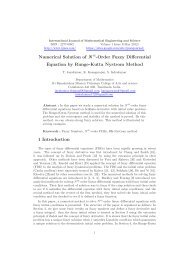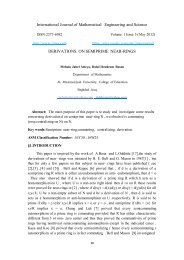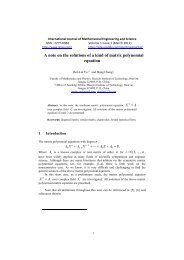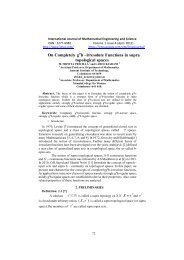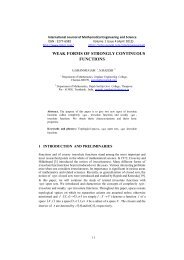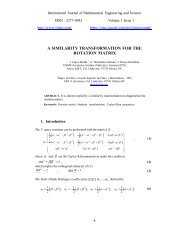THERMAL STRESSES IN A THIN ANNULAR DISC - ijmes
THERMAL STRESSES IN A THIN ANNULAR DISC - ijmes
THERMAL STRESSES IN A THIN ANNULAR DISC - ijmes
You also want an ePaper? Increase the reach of your titles
YUMPU automatically turns print PDFs into web optimized ePapers that Google loves.
International Journal of Mathematical Engineering and Science<br />
ISSN : 2277-6982 Volume 1 Issue 7 (July 2012)<br />
http://www.<strong>ijmes</strong>.com/<br />
https://sites.google.com/site/<strong>ijmes</strong>journal/<br />
<strong>THERMAL</strong> <strong>STRESSES</strong> <strong>IN</strong> A TH<strong>IN</strong> <strong>ANNULAR</strong> <strong>DISC</strong><br />
B. R. Sontakke 1,1 , A. A. Navalekar 1 ,<br />
1<br />
Department of Mathematics, Pratishthan Mahavidyalaya,<br />
Paithan, Dist-Aurangabad-431107<br />
Maharashtra, India.<br />
{brsontakke}@rediffmail.com<br />
Abstract. This paper is concern with direct steady-state thermoelastic problem<br />
to determine the temperature, displacement and stress functions of a thin<br />
annular disc of thickness 2 h , occupying the space<br />
D : a r b,<br />
h z h with the stated boundary conditions. The finite<br />
Hankel transform techniques have been used.<br />
Keywords: Annular disc, steady-state problem, direct thermoelastic problem<br />
Hankel Transform.<br />
1 Introduction<br />
Grysa and Cialkowski [1], Grysa and Koalowski [2] have studied onedimensional<br />
transient thermoelastic Problems derived the heating temperature and<br />
heat flux on the surface of an isotropic infinite slab. Khobragade and Wankhede [3]<br />
have studied the inverse steady-state thermoelastic problem to determine the<br />
temperature, displacement and stress function on the outer curved surface of a thin<br />
19
International Journal of Mathematical Engineering and Science<br />
ISSN : 2277-6982 Volume 1 Issue 7 (July 2012)<br />
http://www.<strong>ijmes</strong>.com/<br />
https://sites.google.com/site/<strong>ijmes</strong>journal/<br />
annular disc occupying the space<br />
D: a r b,<br />
0 z h . The direct problems of<br />
thin circular plate have been studied by Roychaudhari [5] and Wankhede [7].<br />
In the present problem an attempt is made to study the direct steady-state<br />
thermoelastic problem to detrermine the temperature , displacement and stress<br />
functions of a thin annular disc of thickness<br />
2 h , occupying the space<br />
D : a r b,<br />
h z h with the known boundary conditions. The finite Hankel<br />
transform techniques have been used to find the solution of the problem.<br />
2 Result Required<br />
Consider If f (x)<br />
satisfies the Dirichlet’s conditions in the interval (0,a)<br />
then its<br />
finite Hankel transform in that range is defined to be,<br />
f<br />
a<br />
( i ) = xf ( x)<br />
J<br />
<br />
( xi<br />
) dx<br />
<br />
(2.1)<br />
where<br />
0<br />
<br />
i<br />
is the root of the transcendental equation<br />
J<br />
<br />
( ai<br />
) = 0<br />
(2.2)<br />
then, at any point of (0,a)<br />
at which the function f (x)<br />
is continuous,<br />
2<br />
f ( x)<br />
=<br />
a<br />
J<br />
( x<br />
)<br />
i<br />
2 f<br />
<br />
( i<br />
)<br />
(2.3)<br />
2<br />
i [ J<br />
<br />
( ai<br />
)]<br />
where the sum is taken over all the positive roots of the equation (2.2)<br />
properties of Hankel transform in (2.1)<br />
If f (x)<br />
satisfies the Dirichlet’s conditions in the interval (0,a)<br />
then,<br />
f<br />
1. Finite Hankel transform of i. e,<br />
x<br />
20
International Journal of Mathematical Engineering and Science<br />
ISSN : 2277-6982 Volume 1 Issue 7 (July 2012)<br />
http://www.<strong>ijmes</strong>.com/<br />
https://sites.google.com/site/<strong>ijmes</strong>journal/<br />
f<br />
a f<br />
H<br />
<br />
= xJ<br />
<br />
( xi<br />
) dx<br />
x<br />
<br />
0<br />
x<br />
<br />
i<br />
= ( 1)<br />
H<br />
1{<br />
f ( x)}<br />
( 1)<br />
H<br />
1{<br />
f ( x)}<br />
2<br />
2<br />
<br />
f 1 f<br />
i<br />
f<br />
f<br />
<br />
2. H<br />
=<br />
<br />
H<br />
1{<br />
} <br />
1{<br />
}<br />
2<br />
<br />
H<br />
<br />
x<br />
x x<br />
2 x<br />
x<br />
<br />
If f (x)<br />
satisfies the Dirichlet’s conditions in the range b x a and if its finite<br />
Hankel transform in that range is defined to be<br />
H[<br />
f ( x)]<br />
where<br />
=<br />
=<br />
f<br />
<br />
<br />
a<br />
b<br />
( )<br />
i<br />
<br />
f ( x)<br />
J<br />
<br />
( x<br />
) G ( a<br />
) J<br />
<br />
i<br />
is the root of the transcendental equation<br />
J<br />
( b)<br />
G ( a)<br />
J ( a)<br />
G ( b)<br />
=<br />
0<br />
i<br />
<br />
i<br />
<br />
( a<br />
) G ( x<br />
) dx<br />
i<br />
<br />
i<br />
<br />
(2.4)<br />
i i<br />
<br />
i i<br />
(2.5)<br />
then at which the function is continuous<br />
f<br />
2 2<br />
2<br />
i<br />
J<br />
<br />
( bi<br />
) f<br />
<br />
( i)<br />
x)<br />
= J<br />
( ) ( ) ( ) ( ) <br />
2<br />
<br />
xi<br />
G<br />
ai<br />
J<br />
<br />
ai<br />
G<br />
xi<br />
(2.6)<br />
J ( a<br />
) J ( b<br />
)<br />
(<br />
2<br />
i i <br />
i<br />
Now property of hankel transform defined in (2.4)<br />
<br />
b<br />
a<br />
2<br />
<br />
f<br />
2<br />
x<br />
1 f<br />
<br />
<br />
x x<br />
<br />
<br />
J<br />
<br />
( x<br />
) G<br />
2<br />
= <br />
i<br />
f<br />
bJ<br />
2<br />
= <br />
f<br />
i<br />
i<br />
<br />
<br />
<br />
<br />
( a<br />
) J<br />
( x<br />
) G<br />
( )<br />
<br />
( ) a J<br />
i<br />
i<br />
i<br />
i<br />
<br />
<br />
<br />
( a<br />
) G<br />
( x<br />
) G<br />
( a<br />
) J<br />
i<br />
i<br />
i<br />
<br />
<br />
<br />
( a<br />
) G<br />
<br />
( x<br />
) dx<br />
( a<br />
) J<br />
i<br />
i<br />
i<br />
<br />
<br />
( a<br />
) G<br />
( x<br />
)<br />
i<br />
<br />
i<br />
x=<br />
b<br />
<br />
( x<br />
)<br />
i<br />
<br />
x=<br />
a<br />
21
International Journal of Mathematical Engineering and Science<br />
ISSN : 2277-6982 Volume 1 Issue 7 (July 2012)<br />
http://www.<strong>ijmes</strong>.com/<br />
https://sites.google.com/site/<strong>ijmes</strong>journal/<br />
3 Statement of the Problem<br />
Consider a thin circular plate of thickness 2 h occupying the space<br />
D: a r b,<br />
h z h . The differential equation governing the displacement<br />
function U ( r,<br />
z)<br />
as in Nowaki [4] is,<br />
2<br />
U<br />
2<br />
r<br />
1 U<br />
<br />
r r<br />
= (1<br />
) a T<br />
t<br />
(3.1)<br />
with U r<br />
= 0at r = a&<br />
r = b<br />
(3.2)<br />
and<br />
a<br />
t<br />
are the poisson’s ratio and the linear coefficient of thermal expansion of<br />
the material of plate and T is the temperature of the plate satisfying the differential<br />
equation<br />
2<br />
2<br />
T 1 T<br />
T<br />
<br />
2<br />
2<br />
r<br />
r r<br />
z<br />
= 0<br />
subject to the boundary conditions<br />
(3.3)<br />
T<br />
( r,<br />
z)<br />
<br />
<br />
T(<br />
r,<br />
z)<br />
= f ( r)<br />
z <br />
(3.4)<br />
<br />
z=<br />
h<br />
T<br />
( r,<br />
z)<br />
<br />
<br />
T(<br />
r,<br />
z)<br />
= 0<br />
z <br />
(3.5)<br />
<br />
z= h<br />
T ( a,<br />
z)<br />
= 0<br />
(3.6)<br />
T ( b,<br />
z)<br />
= 0<br />
(3.7)<br />
The stress function<br />
<br />
rr<br />
and <br />
<br />
are given by<br />
1 U<br />
<br />
rr<br />
= 2<br />
(3.8)<br />
r r<br />
22
International Journal of Mathematical Engineering and Science<br />
ISSN : 2277-6982 Volume 1 Issue 7 (July 2012)<br />
http://www.<strong>ijmes</strong>.com/<br />
https://sites.google.com/site/<strong>ijmes</strong>journal/<br />
2<br />
U<br />
= 2<br />
2<br />
r<br />
<br />
(3.9)<br />
where is the lames constant while each of the stress functions <br />
rz<br />
, <br />
zz<br />
, <br />
z<br />
are<br />
zero within the plate in the plane state of stress.<br />
The equations (3.1) to (3.9) constitute the mathematical formulation of the<br />
problem under consideration.<br />
4 Solution of the Problem<br />
Applying finite Hankel transform stated in [6] to (3.3) to (3.5) and using (3.6) and<br />
(3.7) one obtains,<br />
2<br />
d T 2<br />
T = 0<br />
2 n<br />
(4.1)<br />
dz<br />
dT(<br />
n,<br />
z)<br />
<br />
T<br />
( n,<br />
z)<br />
= f ( n)<br />
(4.2)<br />
<br />
dz <br />
z=<br />
h<br />
dT(<br />
n,<br />
z)<br />
<br />
T<br />
( <br />
n,<br />
z)<br />
= 0<br />
(4.3)<br />
<br />
dz <br />
z= h<br />
where T denotes the finite Hankel transform of T and <br />
n<br />
is the Hankel transform<br />
parameter. The equation (4.1) is a second order differential equation whose solution is<br />
given by<br />
n<br />
<br />
n<br />
z<br />
<br />
n<br />
z<br />
T( , z)<br />
= Ae Be<br />
(4.4)<br />
23
International Journal of Mathematical Engineering and Science<br />
ISSN : 2277-6982 Volume 1 Issue 7 (July 2012)<br />
http://www.<strong>ijmes</strong>.com/<br />
https://sites.google.com/site/<strong>ijmes</strong>journal/<br />
where A and B are constants.<br />
Using (4.2) and (4.3) in (4.4) we obtain the values of A and B substituting this<br />
values in (4.4) and then inversion of finite Hankel transform lead to<br />
T(<br />
r,<br />
z)<br />
2<br />
2<br />
J0<br />
( na)<br />
<br />
= 2 n<br />
f ( n)<br />
2<br />
2 <br />
n=1<br />
J0<br />
( nb)<br />
J0<br />
( na)<br />
<br />
sinh( n(<br />
z h))<br />
n<br />
cosh( n<br />
( z h))<br />
<br />
2<br />
<br />
(1<br />
n<br />
)sinh(2nh)<br />
2n<br />
cosh(2nh)<br />
<br />
J ( r<br />
) G ( b<br />
) J ( b<br />
) G ( r<br />
)<br />
(4.5)<br />
<br />
0<br />
n<br />
0<br />
n<br />
0<br />
n<br />
0<br />
n<br />
<br />
b<br />
<br />
where f ( n ) = rf ( r)<br />
J0(<br />
rn<br />
) G0<br />
( bn<br />
) J0(<br />
bn<br />
) G0<br />
( rn<br />
) dr and<br />
n<br />
the root of the transcendental equation<br />
a<br />
J<br />
a ) G ( b<br />
) J ( b<br />
) G ( a<br />
) =<br />
0<br />
0( n 0 n 0 n 0 n<br />
Equation (4.5) is the desired solution of the given problem.<br />
are<br />
5 Determination of Thermoelastic Displacement<br />
Substituting this values of T ( r,<br />
z)<br />
from (4.5) in (3.1) one obtains the thermoelastic<br />
displacement function U ( r,<br />
z)<br />
as<br />
U ( r,<br />
z)<br />
2<br />
( )<br />
= J0<br />
na<br />
<br />
2(1<br />
) a t<br />
f ( n)<br />
2<br />
2 <br />
n=1<br />
J0<br />
( nb)<br />
J0<br />
( na)<br />
<br />
sinh( n<br />
( z h))<br />
n<br />
cosh( n(<br />
z h))<br />
<br />
2<br />
<br />
(1<br />
n)sinh(2nh)<br />
2n<br />
cosh(2nh)<br />
(5.1)<br />
<br />
J ( r<br />
) G ( b<br />
) J ( b<br />
) G ( r<br />
)<br />
<br />
0<br />
n<br />
0<br />
n<br />
0<br />
n<br />
0<br />
n<br />
<br />
24
International Journal of Mathematical Engineering and Science<br />
ISSN : 2277-6982 Volume 1 Issue 7 (July 2012)<br />
http://www.<strong>ijmes</strong>.com/<br />
https://sites.google.com/site/<strong>ijmes</strong>journal/<br />
6 Determination of Stress Function<br />
For Using (5.1) in (3.8) and (3.9) the stress functions are obtained as<br />
<br />
rr<br />
2<br />
4(1<br />
) a <br />
t<br />
J<br />
0<br />
( na)<br />
<br />
=<br />
n<br />
f ( n<br />
) 2<br />
2 <br />
r n=1<br />
J<br />
0<br />
( nb)<br />
J0<br />
( na)<br />
<br />
sinh( n<br />
( z h))<br />
n<br />
cosh( n<br />
( z h))<br />
<br />
2<br />
<br />
(1<br />
n)sinh(2nh)<br />
2n<br />
cosh(2nh)<br />
<br />
J ( r<br />
) G ( b<br />
) J ( b<br />
) G ( r<br />
)<br />
<br />
1<br />
n<br />
(6.1)<br />
0<br />
n<br />
0<br />
n<br />
1<br />
n<br />
<br />
<br />
2<br />
2<br />
J0<br />
( na)<br />
<br />
= 4(1<br />
) at n<br />
f ( n)<br />
2<br />
2 <br />
n=1<br />
J0<br />
( nb)<br />
J0<br />
( na)<br />
<br />
sinh( n<br />
( z h))<br />
n<br />
cosh( n(<br />
z h))<br />
<br />
2<br />
<br />
(6.2)<br />
(1<br />
n<br />
)sinh(2nh)<br />
2n<br />
cosh(2nh)<br />
<br />
J '( r<br />
) G ( b<br />
) J ( b<br />
) G '( r<br />
)<br />
<br />
1<br />
n<br />
0<br />
n<br />
0<br />
n<br />
1<br />
n<br />
<br />
7 Conclusion<br />
In this paper, we discussed completely the direct steady state problem of<br />
thermoelastic deformation of a thin annular disc of thickness<br />
2 h , with homogeneous<br />
boundary condition of the third kind is maintained on the lower plane surface while<br />
on upper plane surface, it is maintained at f (r)<br />
, which is known function of r and<br />
the temperature is maintained at zero on curved surfaces of the annular disc.<br />
The finite Hankel transform technique is used to obtain the numerical<br />
results. The temperature , displacement and thermal stresses that are obtained can be<br />
applied to the design of useful structures or machines in engineering applications.<br />
25
International Journal of Mathematical Engineering and Science<br />
ISSN : 2277-6982 Volume 1 Issue 7 (July 2012)<br />
http://www.<strong>ijmes</strong>.com/<br />
https://sites.google.com/site/<strong>ijmes</strong>journal/<br />
References<br />
1. Grysa, K. and Cialkowski, M. J.: On A Certain Inverse Problem of Temperature and<br />
Thermal Stress Fields, Acta Mechanica, vol. 36, pp. 169-185 (1980)<br />
2. Grysa, K. and Kozlowski, Z.: One Dimensional Problem of Temperature and Heat Flux<br />
Determination at the Surfaces of A Thermoelastic Slab Part-I, The Analytical Solutions,<br />
Nuclear Engineering and Design, vol. 74(1), pp. 1-14 (1983)<br />
3. khobragade N. W. and Wankhede P. C.,: An inverse steady-state thermoelastic problem of<br />
thin annular disc, Bull. of pure and appl.sci, vol. 19E(No. 1), pp. 551-555 (2001).<br />
4. Nowaki W.,: The state of stress in a thick circular plate due to temperature field, Bull.<br />
Acad. Polo. Sci. Ser. Tech. 5, pp. 227(1957).<br />
5. Roychaudhary S. K.,: A note on quasi-static stresses in a thin circular plate due to transient<br />
temperature applied along the circumference of a circle over the upper face, Bull. Acad.<br />
Sci. Ser. Tech. 20, pp. 20-21(1972).<br />
6. Sneddon, I. N.,: The use of integral transforms, McGraw-Hill Book Co., chap. 3, pp. 174-<br />
180 (1974)<br />
7. Wankhede P. C.,: On quasi-static thermal stresses in a circular plate. Indian J. of pure and<br />
Appl. Maths, 13, pp.1273-1277 (1982).<br />
26



